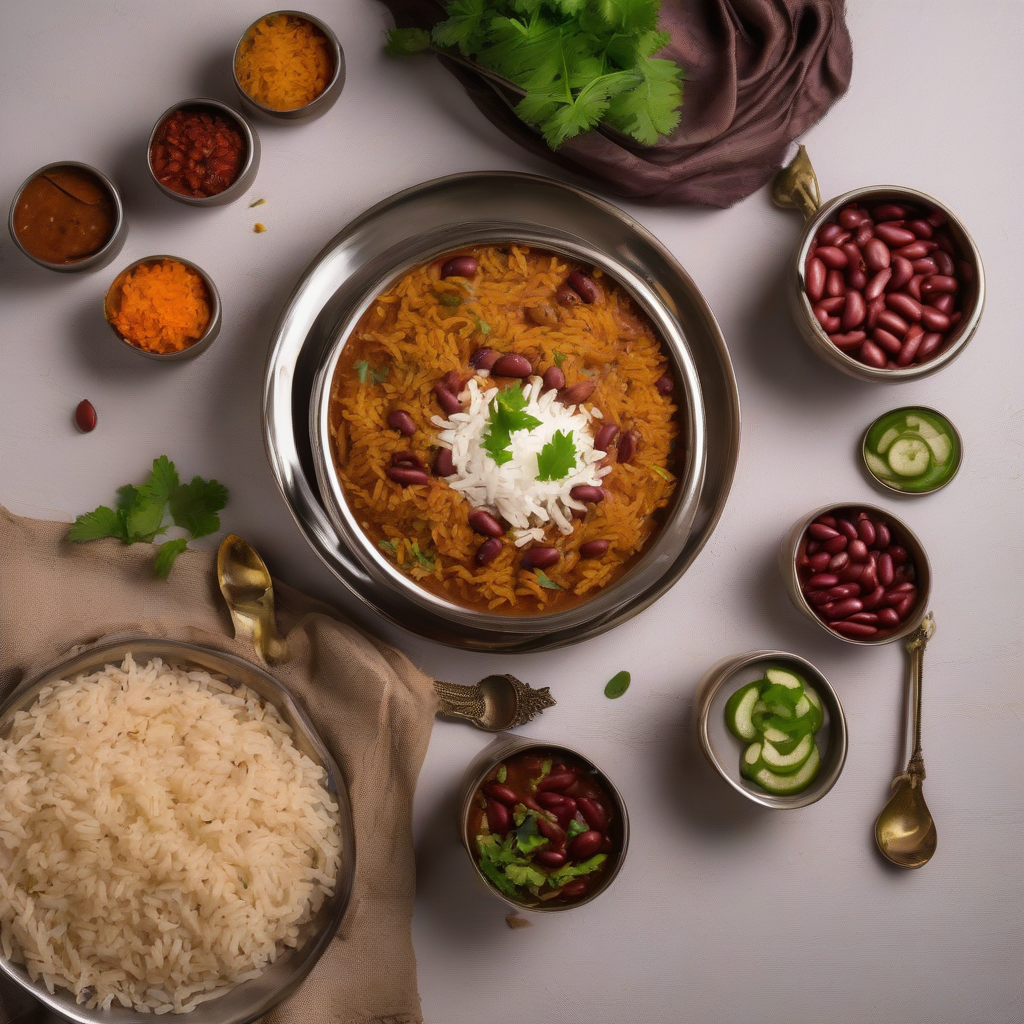Rajma Chawal: Dil Maange More! (The Heart Wants More!)
Namaste and Sat Sri Akal, my foodie friends! Chef Curry Do-Pyaza here, ready to share a recipe that’s close to my heart, and probably yours too: Rajma Chawal! This isn’t just food; it’s a warm hug on a plate, a comforting memory, a taste of home.
In the vibrant tapestry of Indian cuisine, Rajma Chawal holds a special place, especially amongst my Punjabi brothers and sisters! It’s a staple, a dish synonymous with love and family. You’ll find it gracing tables during festive occasions like Lohri, Baisakhi, and even Diwali. It’s the perfect dish to warm you up during the chilly winter months, but honestly, who needs an excuse to enjoy a bowl of creamy, flavorful Rajma? We eat it all year round!
A Little History Lesson (with a Pinch of Masala!)
Did you know that Rajma, the kidney bean, isn’t actually native to India? It journeyed here from Mexico, probably through trade routes. But, like a true Indian, we adopted it, gave it a desi makeover, and transformed it into the beloved dish we know today! The combination with Chawal (rice) makes it a complete protein and a satisfying meal.
Let’s Get Cooking!
Preparation Time: 15 minutes (plus soaking time)
Cooking Time: 60-75 minutes
Ingredients:
- Rajma (Kidney Beans): 1 cup, soaked overnight in plenty of water. Soaking is very important!
- Pyaaz (Onion): 2 medium, finely chopped. We want that golden-brown sweetness!
- Tamatar (Tomatoes): 3 medium, finely chopped. Ripe, juicy ones are the best!
- Adrak-Lahsun Paste (Ginger-Garlic Paste): 1 tablespoon. The dynamic duo!
- Hari Mirch (Green Chillies): 1-2, finely chopped (adjust to your spice level).
- Tel (Oil): 2 tablespoons. Any neutral oil works great.
- Jeera (Cumin Seeds): 1 teaspoon. For that earthy aroma.
- Haldi Powder (Turmeric Powder): 1/2 teaspoon. The golden spice of life!
- Lal Mirch Powder (Red Chilli Powder): 1 teaspoon (or more, if you’re feeling brave!).
- Dhania Powder (Coriander Powder): 2 teaspoons.
- Garam Masala: 1/2 teaspoon. A pinch of magic!
- Amchur Powder (Dry Mango Powder): 1/2 teaspoon (optional, but adds a lovely tang).
- Hara Dhaniya (Fresh Coriander Leaves): For garnish, chopped.
- Namak (Salt): To taste.
Step-by-Step Instructions:
- Soak the Rajma: This is crucial! Soak the Rajma overnight, or for at least 8 hours, in plenty of water. This helps them cook evenly and reduces cooking time.
- Pressure Cook the Rajma: Drain the soaked Rajma and rinse them well. Add them to a pressure cooker with fresh water (about 3 cups) and a pinch of salt. Cook for 6-7 whistles on medium heat, or until the Rajma is soft and easily mashed between your fingers.
- Prepare the Masala: While the Rajma is cooking, heat oil in a large pot or kadhai (wok) over medium heat. Add the Jeera and let it splutter.
- Sauté the Aromatics: Add the chopped Pyaaz and sauté until golden brown. This step is key for a rich flavor!
- Add the Ginger-Garlic Paste and Green Chillies: Sauté for another minute until fragrant.
- Add the Tomatoes: Cook until the tomatoes are soft and the oil starts to separate from the masala. This is called bhunao, and it’s essential for developing the flavors.
- Add the Spices: Add Haldi Powder, Lal Mirch Powder, and Dhania Powder. Sauté for another minute, stirring constantly to prevent burning.
- Combine Rajma and Masala: Once the Rajma is cooked, gently mash a few spoonfuls of it with the back of a spoon. This helps thicken the gravy. Add the cooked Rajma (along with the water it was cooked in) to the masala.
- Simmer and Season: Bring the Rajma to a simmer, then reduce the heat and let it cook for at least 15-20 minutes, or even longer, to allow the flavors to meld together. Add the Garam Masala, Amchur Powder (if using), and salt to taste.
- Garnish and Serve: Garnish with fresh Hara Dhaniya and serve hot with fluffy Basmati Chawal (rice)!
Tips for Best Results:
- Soaking is Key: Don’t skip the soaking step! It makes a huge difference.
- Patience is a Virtue: Allow the Rajma to simmer for a good amount of time to develop the flavors.
- Adjust the Spice: Feel free to adjust the amount of Lal Mirch Powder and Hari Mirch to your liking.
- Don’t Overcook: Be careful not to overcook the Rajma, as it can become mushy.
Cooking It Your Way:
- Gas Stove: Follow the instructions above using a regular pot instead of a pressure cooker. It will take longer for the Rajma to cook, so be patient!
- Induction Stove: The same as a gas stove, just adjust the heat settings accordingly.
- Pressure Cooker: The method described above is the fastest and most common.
- Slow Cooker/Crockpot: Sauté the masala on the stovetop, then transfer it to the slow cooker along with the soaked Rajma and water. Cook on low for 6-8 hours, or on high for 3-4 hours.
- Microwave, Air Fryer, Oven, Fast Cooker: I don’t recommend these methods for Rajma Chawal. The traditional methods bring out the best flavors!
Nutritional Information (Approximate per serving):
- Calories: 350-400
- Protein: 15-20g
- Carbohydrates: 60-70g
- Fat: 5-10g
- Fiber: 10-15g
Serving Suggestions:
- Serve hot with fluffy Basmati Chawal.
- A dollop of fresh Dahi (yogurt) on the side adds a cooling touch.
- Some sliced Pyaaz and a wedge of Nimbu (lemon) complete the experience.
- Papad and Achar (pickle) are always welcome additions!
So there you have it, my friends! A simple, yet incredibly satisfying recipe for Rajma Chawal. I urge you to try this recipe at home. Share this deliciousness with your friends and family. Trust me, they’ll thank you for it!
